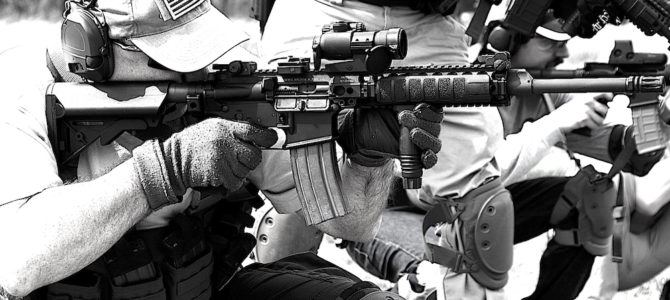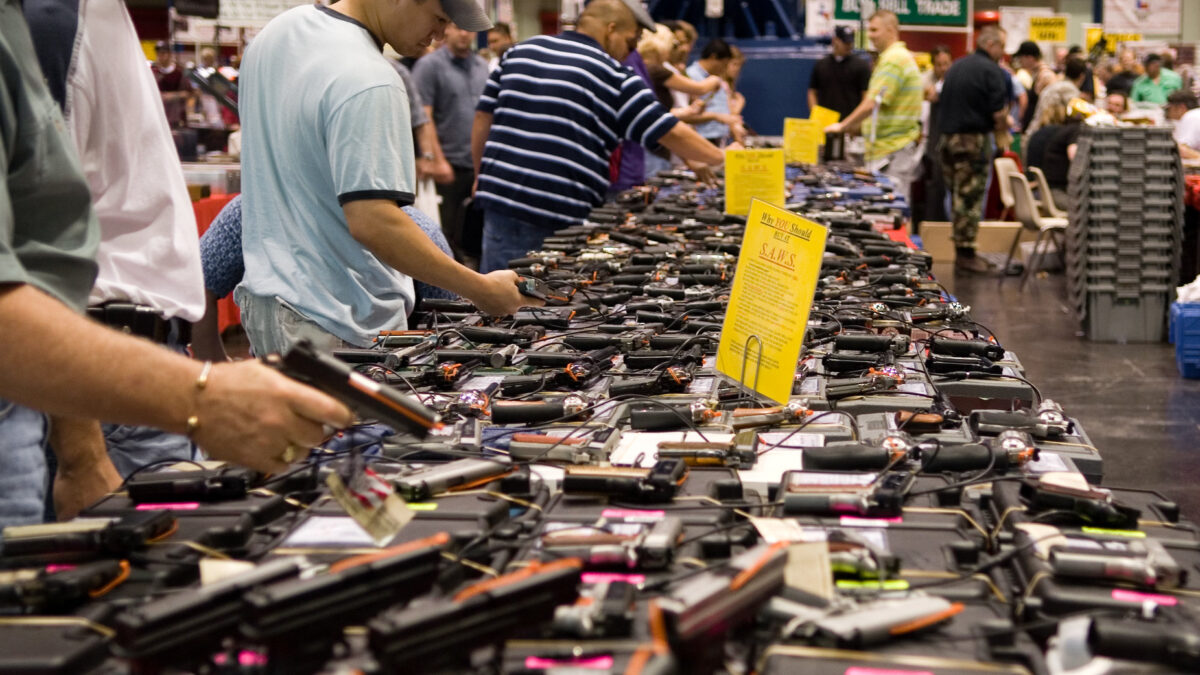
After I suggested reasons to own AR-15s and to fight Democrats’ new attempt to ban them, some readers wrote to request recommendations for the best AR-15s to have and the best ways to equip them. Because self-defense is the primary reason Americans buy guns, including a million AR-15s every year, here are, I believe, the top 10 characteristics of AR-15s configured for defensive purposes and the top 10 components they should have.
Top 10 Characteristics
1. Caliber
U.S. Special Operations Command will soon field rifles in 6.5mm Creedmore, a caliber already in use by the armed citizenry, and the Army is considering a new 6.8mm cartridge. However, for now, an AR-15 should be chambered for 5.56mm NATO because of the variety and availability of ammunition in that caliber. (Note: A 5.56mm AR-15 can also use lower-pressure .223 Remington cartridges, but not vice versa.)

2. Barrel
The barrel should have a chromed chamber and bore for durability and corrosion resistance. To stabilize heavier bullets available today, the barrel’s rifling twist should be one rotation in seven or eight inches. Cold hammer forged barrels are considered a bit more accurate, from one barrel to the next.

3. Lightweight
The rifle should be light enough to be wielded accurately, quickly. As tactical firearm instructor and former Marine Jack Leuba, who helped create the Marine Corps Combat Marksmanship Program, puts it, defensive marksmanship is the ability to shoot “as accurately as needed, as fast as possible, as many times as it takes.”

4. Metallurgy and Quality Control
For durability, the barrel and bolt-carrier assembly should meet or exceed military specifications, as described by Bravo Company, a leading AR-15 manufacturer. Still, it would be a good idea to have a spare bolt and other bolt-carrier assembly parts.

5. Sights and Sling
The rifle should have a non-magnifying red dot sight or a telescopic sight, back-up iron sights, and a tactical two-point sling. More on this momentarily.

6. Ammunition and Magazines
The rifle should have ammunition and ammunition magazines designed for defensive applications. More on this momentarily as well.

7. Gas System Length
If the barrel is 16 inches in length, typical for a carbine, it should have a mid-length gas system for better reliability and durability.
8. Reduced Detectability
As the accompanying photograph shows, muzzle flash can be conspicuous. To reduce the chance of detection by an adversary and to protect your natural night vision when firing at night, the barrel should have a flash suppressor. The exception: a short-barreled rifle equipped with a sound suppressor typically should instead have a muzzle brake. (Short-barreled rifles and “silencers” are regulated under the National Firearms Act and are not legal in all states.) The barrel should also have a non-reflective finish.

9. Knowledgeable, Skilled Owner
Because “high speed” means “precise and efficient,” one of the nation’s preeminent tactical firearm instructors, retired Army Special Forces Master Sgt. Paul Howe, chief instructor at Combat Shooting and Tactics, says “‘High speed’ is being able to do the basics on demand.” That requires training, practice, and study.

You’ll learn more in class if you first study the Marine Corps Rifle Marksmanship manual and retired Army Special Forces Sgt. Major Kyle Lamb’s Green Eyes & Black Rifles.

10. It’s Gotta Work
The rifle’s components and accessories should be durable, mechanically reliable, and tailored to mission requirements. Mission dictates equipment (and everything else), not the other way around.
The Top 10 Components and Accessories
1. Magazines
As a gas tank is to an automobile, a magazine is an integral component of a firearm, not an accessory. Therefore, a magazine ban is a de facto gun ban. Since Democrats want to ban magazines, let’s begin there. The most popular AR-15 magazines are the original aluminum variety and the Magpul PMAG.
The best aluminum magazines are the Okay Industries Sure Feed, Brownell’s, and D&H. Upgrade them with a Magpul self-leveling follower if they are not already so equipped. Aluminum magazines should function reliably for more than 100 loadings. However, if you drop one onto a hard surface, you could permanently damage its feed lips.

Enter the Magpul PMAG. If a PMAG is dropped onto a hard surface, its polymer feed lips won’t bend out of specs. In government tests, GEN M3 PMAGs handled more than 30,000 rounds between malfunctions. PMAGs, widely used by the armed citizenry for years, have been adopted by the military and are the only magazines the Marine Corps authorizes for use in combat.

Because magazines are expendable, you should have one slightly broken-in set for emergencies (a standard “battle load” is seven magazines), typically carried in pouches and a chest rig.

Another set of magazines for practice.

And a few spares.

Make sure your magazines work with your rifle and ammunition. Don’t buy used magazines. If someone is selling them, there’s a reason.
2. Ammunition
Ammunition should have sealed and crimped primers and case necks to prevent blown primers, bullet set-back in the cartridge case, and moisture entering the cartridge. Don’t buy reloaded ammunition unless produced by a major manufacturer, if at all. Never use reloaded ammunition for defensive purposes.
As explained here, bullets for defensive purposes are designed to fragment or to retain mass upon impact. Among the first variety, M193/XM193 and M855 have fully jacketed bullets of 55 and 62 grains, respectively. They’re relatively inexpensive and accurate enough for short- and mid-range use. IMI Mk262 and Black Hills Mk262 use a 77-grain Sierra match bullet for better accuracy.

Top loadings with bullets designed to retain mass are Black Hills with the 50-gr. TSX bullet, Mk318 Mod 0, also called SOST, and Federal XM556SBCT3 with a 62-gr. soft point bullet.
Test your ammunition for muzzle flash in daylight and at night. If possible, chronograph your ammunition and plug the data into the Applied Ballistics online calculator to determine your trajectory.

Top 5.56mm and .223 ammunition manufacturers include, but are not limited to, Black Hills, Federal, Fiocchi, Hornady, Israel Military Industries (IMI), Lake City, Nosler, PMC, Remington, Sig Sauer, Speer, Winchester, and Wolf Gold.
3. Sling
A tactical two-point sling should support the rifle across your front, allow you to stabilize the rifle when aiming, and secure the rifle across your back when you need both hands free to perform some other task.
Two of the best are the Viking Tactics Sling, invented by Sgt. Major Lamb, and the Vickers Combat Application Sling, invented by retired Army Special Forces Master Sgt. Larry Vickers.
Attach the sling near the rear of the stock and the forward end of the handguard, so it doesn’t get in the way when reloading, clearing malfunctions, or operating your light or laser. (You’ll need a quick-detach swivel and an attachment point or a Blue Force Gear U-Loop to attach the sling to the handguard.)
Once the sling is attached, right-handers, drape it over your right shoulder; left-handers, your left shoulder. This allows you to move the rifle out of the way when transitioning to your handgun, as Lamb demonstrates here. Adjust the length so you can go from standing to a kneeling or prone firing position without getting bound up.
4. Stock, Grip, and Handguard
A telescoping Magpul CTR or MOE, Bravo Company, or B5 Systems stock allows you to quickly adjust its length to your physique, the bulk of your clothing and shoulder-borne gear, and your firing position. The preferred variant has a military specification 1.15-inch diameter receiver extension tube, rather than the structurally weaker 1.168-inch variant. To install the receiver extension to the rifle, stake the castle nut or use a Primary Weapons Systems ratchet lock.

The standard A2 grip is fine, but many people prefer the Magpul or Bravo Company with a trapdoor allowing for storage of a spare bolt inside.
If your AR-15 has old-style plastic handguards, replace them with stronger and more ergonomic Magpul or B5 Systems polymer handguards or a free-floating, quad-rail handguard, such as the Centurion or Daniel Defense Omega.

Another option is a complete upper receiver/barrel assembly with a free-floating M-Lok handguard. The longer the handguard, the more places you can grip the rifle and attach a sling, iron front sight, light, and laser device.
5. Optical Sights
Non-magnifying red dot sights are fastest for getting on-target at close range. The Army equips most of its rifles with Aimpoints, which are rugged and run on a single battery for years.


Former Army Special Forces operator Mike Green, who conducts firearm training under the name Green Ops, says “testing by Special Operations personnel found that the quick adjustability of the Aimpoint dot’s brightness helped with precise aiming at distant targets, but the larger reticle of the EOTech allowed for faster target acquisition at close range.”


A telescopic sight is superior for targets at medium and long range, and sometimes at close range. Its reticle should be prominent for targets at close range and have precise aiming points for targets at farther distances. Add a throw lever for rapid magnification adjustments.
An example of a battle-tested variable-power scope is the Nightforce NXS 1-4x with the FC-3G reticle.

Another is the Leupold VX6 1-6x with the CMR2 reticle.

A third rugged scope is the Trijicon TR24 1-4x with a green or red triangle reticle.

The mount for a variable-power scope should be one-piece, with rings that are symmetrical left and right, or top and bottom, such as the Nightforce Unimount. Avoid mounts that have one ring that hooks onto the other and cams into position as you tighten it. They make it hard to get the optic rotated correctly. In the unlikely event a scope failed and you needed to remove it quickly, a quick-release mount, such as the LaRue SPR, would be required.
Another option is a Trijicon ACOG TA-31 or TA-33 with a green or red chevron or horseshoe reticle illuminated by a fiber optic and tritium. Anti-Christian, anti-Jewish, anti-Israel Democrats will especially dislike the TA-31 because its exterior bears a reference to the New Testament verse John 8:12: “Whoever follows me will never walk in darkness, but will have the light of life.”


To attach an optic to an AR-15, first make sure the rifle is unloaded. Hold the mount down and push it forward in the upper receiver’s rail slots as you tighten it and don’t over-tighten. If the mount has threaded cross-bolts or rings, add a little medium Loctite.
Red dot sights should be mounted above the ejection port. Telescopic sights should be positioned fore-to-aft so that you can see clearly through them when standing, kneeling, or prone at any magnification setting.
6. Iron Sights
Modern optical sights are durable but, just in case, have back-up iron sights and practice with them. Install them as described for scope mounts, above. If you don’t have a standard “A-frame” front sight, consider the sturdy Daniel Defense rail-mounted sight. It doesn’t flip down, so it will always be up if you need it.
For the rear sight, if your rifle has a red dot sight, go with a Daniel Defense A1.5, LMT, or Magpul MBUS, MBUS Pro, or MBUS Pro LR. The LMT and MBUS Pro LR are adjustable to compensate for bullet drop associated with shooting at distant targets.

If you mount an iron sight under a scope, you will need a low-profile flip-up model, such as the Magpul MBUS Pro or MBUS Pro Long Range. However, to use the sight, you would have to remove the scope first. An option is to have Magpul MBUS Pro or Surefire/Dueck Defense offset sights.
7. Trigger and Charging Handle
The ALG Defense ACT and BCM PNT are noticeably smoother than standard AR-15 triggers. For defensive purposes, don’t use a competition-style trigger with a light pull weight. The Bravo Company charging handle is more durable than the standard version. Right-handers, get the small or medium latch model; left-handers, the ambidextrous model.
8. Eye and Ear Protection
Refer to the Army’s Authorized Protective Eyewear List for glasses that meet Army standards for protection against ballistic debris. Most glasses on the list also protect your eyes against 100 percent of the sun’s harmful ultraviolet A and B electromagnetic waves.
Also, always use foam ear plugs and protective muffs. MSA, Peltor, and Howard Leight muffs amplify normal sounds, protect against the volume of gunshots, and are flat enough to not interfere with your “stock weld.” In 2020, campaign and vote for congressional candidates who will support legislation to take sound suppressors (“silencers”) out of the NFA.
9. Lights and Laser Devices
Almost anywhere on Earth over a year, it’s night time about half the time. It’s also difficult to see into shadowed areas in daylight conditions.
A light mounted on your handguard may, if used skillfully, solve the problem. Most popular are the Surefire Scouts. The Dual Fuel model is the brightest, an advantage because a bright light can be made dimmer, but a dimmer light can’t be made brighter. A versatile way to configure a Scout is with a Surefire or Unity Tactical pressure pad.

Of course, if you turn on a light, adversaries may see it. Therefore, consider an IR illuminator-equipped laser device and PVS-14 from Tactical Night Vision Company. They are expensive, but if you need them, you will need them more than the money you spent.

10. Paper Targets
The geometric shape the center of which is easiest to discern is a circle. For technique-building practice at distances of 100 yards or less, the SR-42(C) (12.5-inch diameter), B-6(C) (8-in. diameter), B-8(C) (5.5-in. diameter), and Rifle Dot Torture (4-in. diameter) targets should suffice.
The PTAC-1(P) silhouette helps you know where to aim for defensive purposes. To emphasize accuracy, its scoring rings are smaller than those of other silhouettes and narrower than tall, because adversaries are too, they’re more likely to move laterally than vertically, and in a defensive situation a miss to the left or right could hit a bystander.

Final Thought
After President Barack Obama came out for banning AR-15s and magazines, Americans bought almost every AR-15, magazine, and box of ammunition in sight, and prices soared. Right now, the best AR-15s cost less than the cheapest ones will, if the Democrats’ gun-ban legislation gains steam, which the fake news media will make sure happens at the first opportunity. For that and other reasons, now might be the best time to get the most effective fighting firearm your money can buy.










